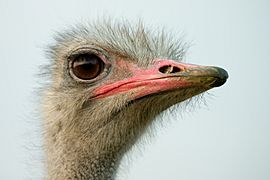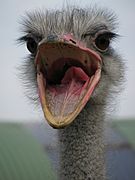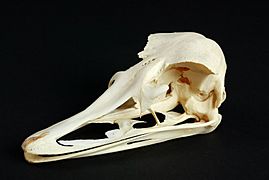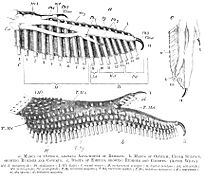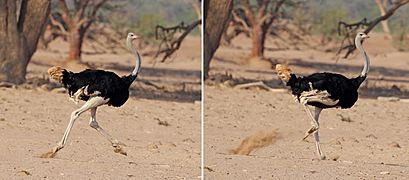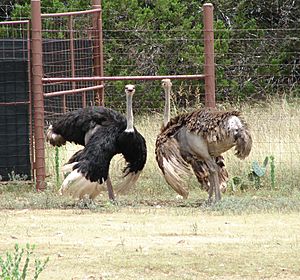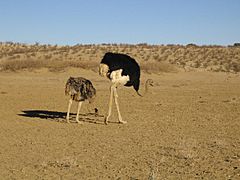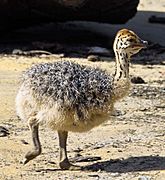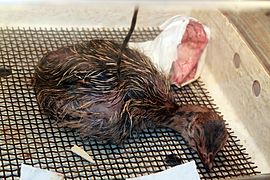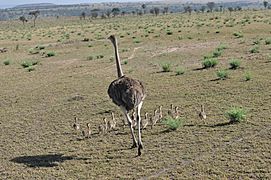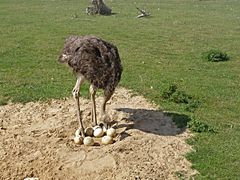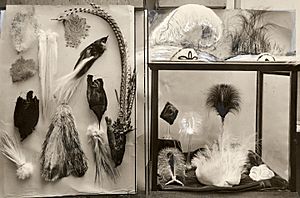Common ostrich facts for kids
Quick facts for kids Common ostrich |
|||||
|---|---|---|---|---|---|
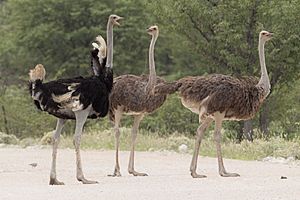 |
|||||
| South African ostrich male (left) and females (S. camelus australis) | |||||
| Conservation status | |||||
| Scientific classification | |||||
| Genus: |
Struthio
|
||||
| Species: |
camelus
|
||||
| Subspecies | |||||
|
|||||
 |
|||||
Struthio camelus distribution map
|
|||||
The common ostrich (Struthio camelus), or simply ostrich, is a huge flightless bird that lives in parts of Africa. It's one of only two types of ostriches still alive today. Ostriches are the only living members of their group, called Struthio. The other living ostrich is the Somali ostrich, which was recognized as its own species in 2014.
Ostriches are known for their unique look. They have very long necks and legs. They can run super fast, reaching speeds of about 70 km/h (43 mph) in short bursts. This makes them the fastest land bird! The common ostrich is also the largest living bird species. It lays the biggest eggs of any living bird.
Ostriches mostly eat plants, but they also munch on invertebrates and small reptiles. They usually live in groups of 5 to 50 birds. If an ostrich feels threatened, it might lie flat on the ground to hide. If it can't hide, it will run away. If an ostrich is cornered, it can kick very hard with its powerful legs. Male ostriches often fight for a group of two to seven females during mating season.
People around the world farm ostriches. Their feathers are used for decorations and feather dusters. Their skin is made into leather products. Ostrich meat is also sold, and it's known for being lean.
Contents
What Does an Ostrich Look Like?
Common ostriches usually weigh between 63 to 145 kilograms (139–320 lb). That's like one or two adult humans! Males can be 2.1 to 2.8 m (6 ft 11 in to 9 ft 2 in) tall, and females are usually 1.7 to 2.0 m (5 ft 7 in to 6 ft 7 in) tall. Baby ostriches are light brown with dark spots. They grow about 25 cm (9.8 in) each month in their first year. Ostriches can live for 40 to 45 years.
Adult male ostriches have mostly black feathers. Their wing and tail feathers are white. Females and young males are grayish-brown and white. The head and neck of both male and female ostriches have very few feathers, just a thin layer of soft down. A female's neck and thighs are pinkish-gray, while a male's can be gray or pink.
-
Male running in Namibia
Their long necks and legs allow their heads to reach up to 2.8 m (9 ft) above the ground. This helps them spot predators from far away. Their eyes are huge, about 50 mm (2.0 in) across. This makes them the largest eyes of any land animal! Their eyes are also shaded from the sun.
Ostrich legs are strong and have no feathers. They have scales on the lower part of their legs. Males have red scales, and females have black scales. Ostriches have only two toes on each foot. Most birds have four. One toe has a nail that looks like a hoof. Having fewer toes helps them run faster to escape predators. They can cover 3 to 5 m (9.8 to 16.4 ft) in a single stride! Their wings can spread about 2 meters (6 ft 7 in) wide. Even though they can't fly, their wings help them balance when running fast.
Ostrich feathers are soft and fluffy. They don't have the tiny hooks that make flying birds' feathers smooth. These soft feathers act like insulation, keeping the ostrich warm or cool. Ostriches can handle big temperature changes. They use their wings to cover their bare legs to stay warm or leave them uncovered to cool down.
Where Do Ostriches Live?
Common ostriches used to live in many parts of Africa and Asia. Today, they mostly live in the savannas and semi-deserts of Africa. You can find them both north and south of the rainforest areas. They prefer open land. Some ostriches that escaped from farms in Australia now live wild in the Australian outback. Sadly, the Arabian ostrich subspecies, which lived in the Middle East, was hunted until it became extinct around the mid-1900s.
How Do Ostriches Behave?
During winter, common ostriches often live alone or in pairs. But during breeding season or very dry times, they gather in groups of 5 to 100 birds. These groups are often led by a dominant female. They sometimes travel with other grazing animals like zebras or antelopes. Ostriches are active during the day, especially in the early morning and late afternoon.
Ostriches have excellent eyesight and hearing. This helps them spot predators like lions from far away. When a predator chases them, they can run over 70 km/h (43 mph). They can keep a steady speed of 50 km/h (31 mph). If they need to hide, they lie down and flatten their heads and necks on the ground. From a distance, they look like a small mound of earth, especially with the heat haze in their hot homes.
If running away isn't an option, ostriches can deliver powerful kicks with their legs. They can only kick forward, but their kicks are strong enough to cause serious injury or even kill a predator.
The "Head in the Sand" Myth
You might have heard that ostriches bury their heads in the sand to hide from danger. This is a myth! It probably started a long time ago. One idea is that people misunderstood how ostriches lie low to hide. When they lie down, their heads and necks are flat on the ground, making them hard to see. Another idea is that it comes from how ostriches dig holes in the sand for their eggs. They use their beaks to rotate the eggs during incubation. This might have looked like they were burying their heads. Ostriches do swallow sand and pebbles, which helps them digest their food.
What Do Ostriches Eat?
Ostriches mainly eat seeds, shrubs, grass, fruit, and flowers. Sometimes, they also eat insects like locusts and small lizards. Since they don't have teeth, they swallow pebbles. These pebbles act like little grinders in their gizzard, helping them break down tough plant food. Ostriches can go without drinking water for several days. They get moisture from the plants they eat. But they do enjoy drinking water and taking baths when they find it.
How Do Ostriches Mate?
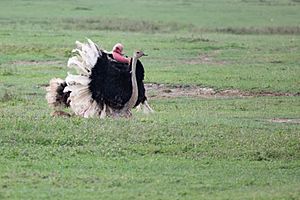
Common ostriches become ready to have babies when they are 2 to 4 years old. Females mature a bit earlier than males. The mating season usually starts in March or April and ends before September. Male ostriches will make booming sounds to protect their territory and their group of females. A male might mate with several females, but he will form a special bond with one main female.
The male ostrich performs a dance to attract a mate. He flaps his wings, alternating them, and pokes the ground with his beak. He might even pretend to clear a nest in the soil. The female will then run in a circle around him with her wings lowered.
Female ostriches lay their fertilized eggs in one shared nest. This nest is a simple pit, about 30 to 60 cm (12–24 in) deep and 3 m (9.8 ft) wide, scraped out by the male. The main female lays her eggs first. When it's time to cover them, she might push out some extra eggs from other females, usually leaving about 20 eggs. Female ostriches can tell their own eggs apart from others in the nest.
Ostrich eggs are the largest of all bird eggs. On average, they are 15 cm (5.9 in) long, 13 cm (5.1 in) wide, and weigh 1.4 kilograms (3.1 lb). That's more than 20 times the weight of a chicken's egg! They are creamy white and have thick shells with small pits.
The females sit on the eggs during the day, and the males sit on them at night. This helps hide the nest because the drab female blends in with the sand, and the black male is hard to see in the dark. The eggs hatch after 35 to 45 days. Sadly, fewer than 10% of nests survive, and only about 15% of the chicks live to be one year old. But if an ostrich makes it to adulthood, it can live a very long time. Some captive ostriches have lived over 62 years!
Who Preys on Ostriches?
Ostriches face many dangerous predators in the African savanna. cheetahs, lions, leopards, African hunting dogs, spotted hyenas, and Nile crocodiles all hunt ostriches of all ages. Ostriches can often outrun most predators. So, predators usually try to sneak up on them using bushes or other hiding spots. Cheetahs are especially good at hunting adult ostriches because they are also incredibly fast.
Smaller predators like jackals, various birds of prey, warthogs, mongoose, and Egyptian vultures prey on ostrich nests and young chicks. Egyptian vultures are known to throw stones at ostrich eggs to crack them open! If their nest or chicks are in danger, parent ostriches might pretend to be hurt to distract the predator. But they can also fight fiercely, especially when defending their young. They have even been known to kill lions in these fights!
Ostriches and Humans
Ostriches have been important to human cultures for thousands of years. In ancient Mesopotamia and Egypt, they were admired. People in the Kalahari Desert use ostrich eggshells as water containers and make jewelry from them.
How Are Ostriches Used by Humans?
In ancient Roman times, ostriches were used in games or for cooking. People have hunted and farmed them for their feathers, which were popular for decorating clothes and hats in the 1800s. Their skin is also very valuable for making leather. In the 18th century, ostriches were almost hunted to extinction. So, people started farming them in the 19th century.
Today, ostrich farming is widespread. Ostrich meat tastes similar to lean beef and is low in fat and cholesterol. It's also high in calcium, protein, and iron. Some ostrich farms also offer agri-tourism, where visitors can take tours or even ride ostriches!
Can Ostriches Be Dangerous?
Wild ostriches usually stay away from humans because they see us as potential predators. If you get too close, they often run away. However, ostriches can be very aggressive if they feel threatened, especially if they are cornered. They might also attack if they are defending their territory or their babies.
When an ostrich attacks a person, it delivers powerful kicks with its strong feet, which have long claws. These kicks can cause serious injury or even death. In one area of South Africa where many ostrich farms are located, it's estimated that two to three attacks resulting in serious injury or death happen each year.
Ostrich Racing

In some countries, people race on the backs of ostriches. This is common in Africa and less common elsewhere. Ostriches are ridden like horses, with special saddles and reins. However, they are much harder to control than horses!
Ostrich racing is a part of modern South African culture. In the United States, an attraction called 'The Ostrich Farm' opened in Jacksonville, Florida, in 1892. Its races became very famous. Today, places like Chandler, Arizona, host an annual "Ostrich Festival" that features ostrich races.
Images for kids
See also
 In Spanish: Avestruz para niños
In Spanish: Avestruz para niños



